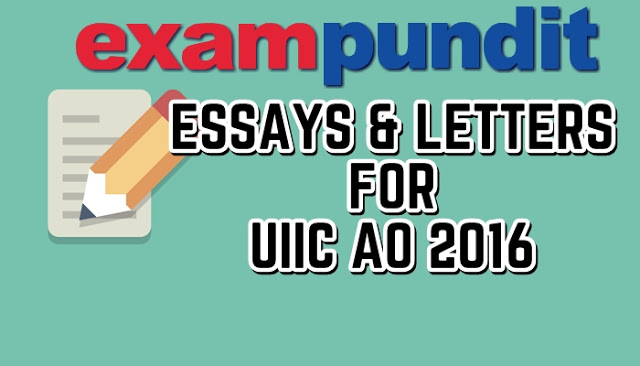Hello and welcome to exampundit. Here is the 3rd Essay from the First Essay Contest. The topic is about Crop insurance in India needs innovation and not subsidy.
Optimus Prime – Crop
insurance in India needs innovation and not subsidy
insurance in India needs innovation and not subsidy
Pradhan Mantri Fasal Bima Yojana
(PMFBY) was launched to boost the farming sector. Under this scheme, for kharif
crops a premium of 2% and for Rabi crops premium of 1.5% is to be paid by the
farmers. Whereas for horticultural crops premium will be 5%. This premium which
is to be paid by the farmers is low and the remaining amount will be paid by
the government on account of crop loss due to natural calamities.
(PMFBY) was launched to boost the farming sector. Under this scheme, for kharif
crops a premium of 2% and for Rabi crops premium of 1.5% is to be paid by the
farmers. Whereas for horticultural crops premium will be 5%. This premium which
is to be paid by the farmers is low and the remaining amount will be paid by
the government on account of crop loss due to natural calamities.
Under this scheme, there is no
upper limit on subsidy given by the Government. Whatever the amount may be, it
will be paid by the Government. In Agriculture sector there has been a trend of
subsidy and little investment. There are some ill effects of subsidy.
upper limit on subsidy given by the Government. Whatever the amount may be, it
will be paid by the Government. In Agriculture sector there has been a trend of
subsidy and little investment. There are some ill effects of subsidy.
For example, a farmer gets
subsidy for digging up tube well and further subsidy in electricity, due to
this over consumption of ground water happens which creates groundwater crises.
Similarly subsidy is given for fertilizers. Overuse of fertilizers affects soil
health and plant growth. The insurance companies will provide crop insurance if
they see positive outcome of it. The scheme should clearly address the terms
and conditions for claims. Then reinsurance companies will be willing to absorb
risks from general insurance companies.
subsidy for digging up tube well and further subsidy in electricity, due to
this over consumption of ground water happens which creates groundwater crises.
Similarly subsidy is given for fertilizers. Overuse of fertilizers affects soil
health and plant growth. The insurance companies will provide crop insurance if
they see positive outcome of it. The scheme should clearly address the terms
and conditions for claims. Then reinsurance companies will be willing to absorb
risks from general insurance companies.
The use of technology is an
important feature of this scheme for quicker settlement of claims. Smartphones
will be used to capture and upload data of crop cutting to reduce delays in
claim settlement to farmers. Remote sensing will be used to reduce crop cutting
experiments. This will encourage farmers to get crop insurance. So we can say
that innovative ways and use of technology in settling claims will help the
crop insurance in India rather than subsidy.
important feature of this scheme for quicker settlement of claims. Smartphones
will be used to capture and upload data of crop cutting to reduce delays in
claim settlement to farmers. Remote sensing will be used to reduce crop cutting
experiments. This will encourage farmers to get crop insurance. So we can say
that innovative ways and use of technology in settling claims will help the
crop insurance in India rather than subsidy.
Arya Stark – Crop insurance in India needs innovation and
not subsidy
not subsidy
Agriculture in India is highly
susceptible to risks like droughts and floods. It is necessary to protect
farmers from aftermaths of natural calamities and ensure their credit
eligibility for the next season. For this purpose, the government of India have
been implementing many crop insurance schemes since early 1980s. And with the
gap of years it has updated these schemes with new changes. This year also the government
of India launched the Pradhan Mantri Fasal Bima Yojana(PMFBY) which has
replaced the earlier National Agriculture Insurance Scheme (NAIS). The revamped
crop insurance scheme is welcome, but the scheme has some points which are
important to consider, before implementation.
susceptible to risks like droughts and floods. It is necessary to protect
farmers from aftermaths of natural calamities and ensure their credit
eligibility for the next season. For this purpose, the government of India have
been implementing many crop insurance schemes since early 1980s. And with the
gap of years it has updated these schemes with new changes. This year also the government
of India launched the Pradhan Mantri Fasal Bima Yojana(PMFBY) which has
replaced the earlier National Agriculture Insurance Scheme (NAIS). The revamped
crop insurance scheme is welcome, but the scheme has some points which are
important to consider, before implementation.
Although the low premium will
drive more and more enrolment & make the insurance scheme more viable for
insurers. But it remains to be seen, if the unit for crop loss has been reduced
to the village level. And also there are no details of how the scheme will use
to assess crop losses. Subsidising crop insurance premium is being risky and
unsustainable in long run. While farmers may choose suboptimal cropping
patterns, persons may lax on preventive caring measures. It may not show
interest while collecting premiums as the deficit will be financed by the government,
no matter how much the deficit promised in PMFBY.
drive more and more enrolment & make the insurance scheme more viable for
insurers. But it remains to be seen, if the unit for crop loss has been reduced
to the village level. And also there are no details of how the scheme will use
to assess crop losses. Subsidising crop insurance premium is being risky and
unsustainable in long run. While farmers may choose suboptimal cropping
patterns, persons may lax on preventive caring measures. It may not show
interest while collecting premiums as the deficit will be financed by the government,
no matter how much the deficit promised in PMFBY.
Investment in agricultural
infrastructure / research would be more equitable as opposed to subsidises to
crop insurance and may yield more long term benefits. The subsidies
sustainability is questionable in the long run. The fiscal costs of the subsidy
are high. This particularly challenging in the wake of limits set by FRBM
act,2003. Since subsidy covers the entire risk premium which is difference between
the market decided rate and 1.5%/2%, This can subject to market fluctuations
and can rise drastically in the future. The private companies may not opt for
it because of the risks associated with monsoons which affect the expected
produce. If the production failed, every farmer would claim the insurance from
the company & then the company will bankrupt.
infrastructure / research would be more equitable as opposed to subsidises to
crop insurance and may yield more long term benefits. The subsidies
sustainability is questionable in the long run. The fiscal costs of the subsidy
are high. This particularly challenging in the wake of limits set by FRBM
act,2003. Since subsidy covers the entire risk premium which is difference between
the market decided rate and 1.5%/2%, This can subject to market fluctuations
and can rise drastically in the future. The private companies may not opt for
it because of the risks associated with monsoons which affect the expected
produce. If the production failed, every farmer would claim the insurance from
the company & then the company will bankrupt.
There is need of innovation
in the designing of crop insurance products to make it profitable for private
companies. After all the company invests its money to generate income. More and
more private companies will be attracted, if it proved to be profitable. It is
more compatible to practice reinsurance worldwide, which make primary insurers
to cover their local/regional risks by reinsurance using themselves with
international reinsurers. The government’s objective is commendable but its
solution response to the problems needs some correction to meet its objective
in cost effective way. There is need to go by innovative approach in crop
insurance scheme to ease the burden on the Indian economy.
in the designing of crop insurance products to make it profitable for private
companies. After all the company invests its money to generate income. More and
more private companies will be attracted, if it proved to be profitable. It is
more compatible to practice reinsurance worldwide, which make primary insurers
to cover their local/regional risks by reinsurance using themselves with
international reinsurers. The government’s objective is commendable but its
solution response to the problems needs some correction to meet its objective
in cost effective way. There is need to go by innovative approach in crop
insurance scheme to ease the burden on the Indian economy.
Sponsored
(adsbygoogle = window.adsbygoogle || []).push({});
Arnav Dragneo – Crop insurance in India needs innovation and
not subsidy
not subsidy
Agriculture is the spine of every
nation.Its the only source to feed the hungry nation and like any other nation
India’s agriculture sector takes the responsibility of feeding the huge population
. The life of many Indian farmers has been miserable due to drought , floods
and other natural calamities which have spread havoc and distress. Hence
introduction of crop insurance have shun some light and hope to Indian farmers
to prepare themselves from worse situations. Pradhan mantri Fasal Bima yojna
launched recently by our prime minister which includes several benefits
including subsidies to India’s farmers with low premiums which will help
farmers fight and save money and resources for next season. But is it enough to
make farmers believe they are in safe hands?. India’s farm sector is burdened
with ill administration and far too little investment. Placing the availability
of insurance and giving subsidy or premium does very little as many farmers are
unaware of this circumstances.Its the responsibilities of government to open
the options to innovate the existing insurance scheme and design it according
to needs and situation.
nation.Its the only source to feed the hungry nation and like any other nation
India’s agriculture sector takes the responsibility of feeding the huge population
. The life of many Indian farmers has been miserable due to drought , floods
and other natural calamities which have spread havoc and distress. Hence
introduction of crop insurance have shun some light and hope to Indian farmers
to prepare themselves from worse situations. Pradhan mantri Fasal Bima yojna
launched recently by our prime minister which includes several benefits
including subsidies to India’s farmers with low premiums which will help
farmers fight and save money and resources for next season. But is it enough to
make farmers believe they are in safe hands?. India’s farm sector is burdened
with ill administration and far too little investment. Placing the availability
of insurance and giving subsidy or premium does very little as many farmers are
unaware of this circumstances.Its the responsibilities of government to open
the options to innovate the existing insurance scheme and design it according
to needs and situation.
Insurance companies should hire agents(Agriculture
officers) to communicate with farmers and figure out probable situation for
positive actuarial outcome. Premiums should be realistic as too much loss for
the government can bring the same fate happened before. A valued policies
should be formulated according to the geographical condition and taking into
account the future risk. Valued policy should also make sure farmers profit
margin for a better economic results. Technological support can yeild solution
to many drastic problems for example actuarial tools to demonstrate efficiency
and gains for faster settlements , weather forecasting and passing the
information to farmers and use of drones can ensure many benefits.
officers) to communicate with farmers and figure out probable situation for
positive actuarial outcome. Premiums should be realistic as too much loss for
the government can bring the same fate happened before. A valued policies
should be formulated according to the geographical condition and taking into
account the future risk. Valued policy should also make sure farmers profit
margin for a better economic results. Technological support can yeild solution
to many drastic problems for example actuarial tools to demonstrate efficiency
and gains for faster settlements , weather forecasting and passing the
information to farmers and use of drones can ensure many benefits.
A shift is
need from a social crop insurance to a market based insurance schemes where the
product design and premium can actually yield positive results and attract
private insurance and reinsurance companies.Promotion of products ,
streamlining budget and assistance to farmers are some of the key features for
the upliftment of the market. Hence ensuring mitigation of risk for the farmers
and helping them for high yield is an attempt that should be welcomed.
need from a social crop insurance to a market based insurance schemes where the
product design and premium can actually yield positive results and attract
private insurance and reinsurance companies.Promotion of products ,
streamlining budget and assistance to farmers are some of the key features for
the upliftment of the market. Hence ensuring mitigation of risk for the farmers
and helping them for high yield is an attempt that should be welcomed.
Click Here for all the other essays.
Regards
Team ExamPundit
This post was last modified on November 27, 2017 8:56 am





